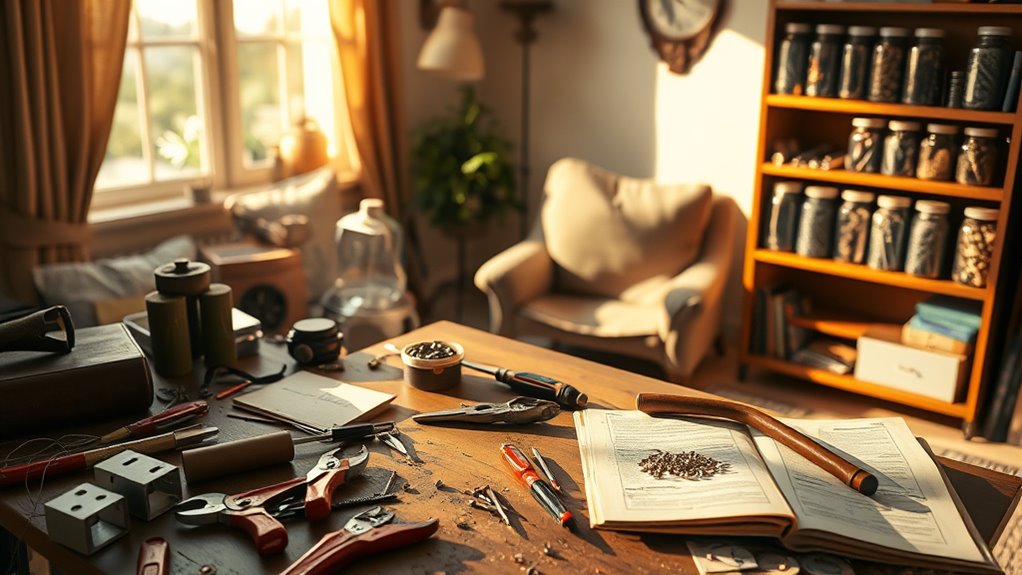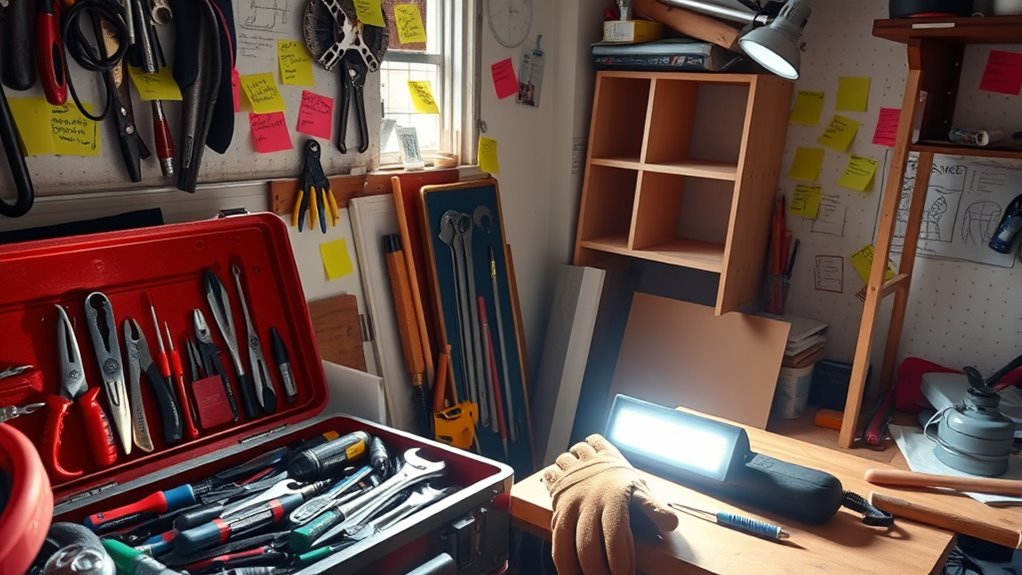To start adopting a fix-it mindset at home, view problems as challenges you can solve rather than obstacles. Focus on high-priority areas like the kitchen, closets, or garage, and break big tasks into manageable steps. Establish simple routines for daily maintenance, like tidying for five minutes or doing quick declutters. Stay consistent and recognize small efforts as progress. Keep in mind, developing sustainable habits transforms home challenges into opportunities for positive change—if you keep going, you’ll learn more about lasting solutions.
Key Takeaways
- Identify the most cluttered or chaotic area, like the kitchen or garage, as your starting point.
- Break down large organizing projects into small, manageable steps to prevent overwhelm.
- Establish daily routines, such as 5-minute tidying sessions, to build consistent organization habits.
- Approach home challenges proactively, viewing them as opportunities to improve and create sustainable habits.
- Focus on long-term solutions and ongoing maintenance rather than temporary fixes for lasting results.

Having a fix-it mindset at home means you see problems as challenges to be solved rather than insurmountable obstacles. This perspective encourages you to take proactive steps toward improving your living space, making home organization a natural starting point. When your environment feels cluttered or chaotic, it’s easy to get overwhelmed. But by approaching disorganization as something fixable, you empower yourself to make tangible changes. Begin by identifying the areas that need the most attention—be it a cluttered kitchen counter, overflowing closets, or a disorganized garage. Break down these tasks into manageable steps, and tackle them one at a time. This approach prevents burnout and keeps you motivated, turning a formidable project into a series of achievable goals. Embracing a problem-solving mindset can transform how you handle home challenges and foster long-term habits. Incorporating regular routines into your daily life is a key part of maintaining a well-organized home. When you see home organization as an ongoing process, not a one-time fix, it becomes easier to stay on top of clutter and mess. Establish specific routines for daily tasks—like tidying up after meals, putting away laundry, or decluttering your workspace. These habits create a rhythm that keeps your home manageable and prevents messes from piling up. For example, dedicating five minutes each evening to clearing surfaces or organizing mail can make a huge difference over time. The idea is to make organization a seamless part of your daily routines rather than an overwhelming chore.
Frequently Asked Questions
How Long Does It Typically Take to Develop a Fix-It Mindset?
It usually takes about three to six weeks to develop a fix-it mindset through consistent habit formation. As you actively approach problems with a solutions-oriented attitude daily, your mindset development accelerates. Staying committed and practicing problem-solving regularly helps solidify this new perspective. Remember, persistence is key—over time, your proactive habits will become second nature, making it easier to handle issues confidently and efficiently at home.
Can Children Benefit From Adopting a Fix-It Mindset at Home?
Think of children as tiny engineers, ready to learn. Yes, they can benefit from adopting a fix-it mindset at home. Your parental guidance helps build their emotional resilience and problem-solving skills. When you encourage them to try, learn, and persist through challenges, you’re empowering them to handle setbacks confidently. This mindset fosters independence and resilience, setting a strong foundation for their future growth and adaptability in life’s repairs and puzzles.
What Are Common Obstacles in Maintaining a Fix-It Mindset?
You might face obstacles like mindset consistency and emotional resistance when maintaining a fix-it mindset. Staying committed requires regular effort and patience, especially when setbacks occur. Emotional resistance can make it hard to stay positive or motivated, but recognizing these feelings helps you push through. Consistently reinforcing your mindset and addressing emotional hurdles keeps you focused on fixing problems rather than avoiding them.
How Do I Motivate Family Members to Participate?
You can spark your family’s interest like igniting a flame by highlighting their role as the heroes of your home repairs. Use positive reinforcement, celebrating small wins and progress to keep motivation high. Make involvement fun and collaborative, turning chores into team adventures. When family members see their efforts valued and rewarded, they’ll be more enthusiastic to participate, transforming fix-it tasks into opportunities for connection and empowerment.
Are There Specific Tools or Resources Recommended for Beginners?
You should try DIY kits and online tutorials for beginners. DIY kits provide hands-on experience and make fixing things approachable, while online tutorials offer step-by-step guidance you can follow at your own pace. These resources build confidence and skills, making it easier to motivate your family members to participate. Start with simple projects, and you’ll find that everyone becomes more engaged and enthusiastic to contribute to home repairs.
Conclusion
Now that you’ve begun to embrace the fix-it mindset, think of your home as a garden waiting to bloom. Every small repair is like planting a seed—nurture it, and watch your space flourish. With each problem you tackle, you’re building a sturdy foundation for a more confident, resilient home. Remember, you hold the keys to transforming chaos into comfort—so roll up your sleeves and watch your home become a masterpiece of your own making.








